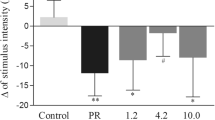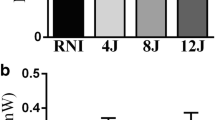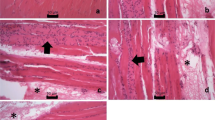Abstract
The aim of this work is to analyze the effects of LED therapy at 940 nm or cold water immersion therapy (CWI) after an acute bout of exercise on markers of muscle damage and inflammation. Thirty-two male Wistar rats were allocated into four groups: animals kept at rest (control), exercised animals (E), exercised + CWI (CWI), and exercised + LED therapy (LED). The animals swam for 100 min, after which blood samples were collected for lactate analysis. Animals in the E group were returned to their cages without treatment, the CWI group was placed in cold water (10°C) for 10 min and the LED group received LED irradiation on both gastrocnemius muscles (4 J/cm2 each). After 24 h, the animals were killed and the soleus muscles were submitted to histological analysis. Blood samples were used for hematological and CK analyses. The results demonstrated that the LED group presented fewer areas of muscle damage and inflammatory cell infiltration and lower levels of CK activity than the E group. Fewer areas of damaged muscle fiber were observed in the LED group than in CWI. CWI and LED did not reduce edema areas. Hematological analysis showed no significant effect of either treatment on leukocyte counts. The results suggest that LED therapy is more efficient than CWI in preventing muscle damage and local inflammation after exercise.






Similar content being viewed by others
References
Aoi W, Naito Y, Takanami Y, Kawai Y, Sakuma K, Ichikawa H, Yoshida N, Yoshikawa T (2004) Oxidative stress and delayed-onset muscle damage after exercise. Free Radic Biol Med 37(4):480–487. doi:10.1016/j.freeradbiomed.2004.05.008
Ascensao A, Rebelo A, Oliveira E, Marques F, Pereira L, Magalhaes J (2008) Biochemical impact of a soccer match—analysis of oxidative stress and muscle damage markers throughout recovery. Clin Biochem 41(10–11):841–851. doi:10.1016/j.clinbiochem.2008.04.008
Iguchi M, Shields RK (2010) Quadriceps low-frequency fatigue and muscle pain are contraction-type-dependent. Muscle Nerve 42(2):230–238. doi:10.1002/mus.21679
Chatzinikolaou A, Fatouros IG, Gourgoulis V, Avloniti A, Jamurtas AZ, Nikolaidis MG, Douroudos I, Michailidis Y, Beneka A, Malliou P, Tofas T, Georgiadis I, Mandalidis D, Taxildaris K (2010) Time course of changes in performance and inflammatory responses after acute plyometric exercise. J Strength Cond Res 24(5):1389–1398. doi:10.1519/JSC.0b013e3181d1d318
Paulsen G, Egner IM, Drange M, Langberg H, Benestad HB, Fjeld JG, Hallen J, Raastad T (2010) A COX-2 inhibitor reduces muscle soreness, but does not influence recovery and adaptation after eccentric exercise. Scand J Med Sci Sports 20(1):e195–e207. doi:10.1111/j.1600-0838.2009.00947.x
Crameri RM, Aagaard P, Qvortrup K, Langberg H, Olesen J, Kjaer M (2007) Myofibre damage in human skeletal muscle: effects of electrical stimulation versus voluntary contraction. J Physiol 583(Pt 1):365–380. doi:10.1113/jphysiol.2007.128827
Lauritzen F, Paulsen G, Raastad T, Bergersen LH, Owe SG (2009) Gross ultrastructural changes and necrotic fiber segments in elbow flexor muscles after maximal voluntary eccentric action in humans. J Appl Physiol 107(6):1923–1934. doi:10.1152/japplphysiol.00148.2009
Gleeson M (2007) Immune function in sport and exercise. J Appl Physiol 103(2):693–699. doi:10.1152/japplphysiol.00008.2007
Gokhale R, Chandrashekara S, Vasanthakumar KC (2007) Cytokine response to strenuous exercise in athletes and non-athletes–an adaptive response. Cytokine 40(2):123–127. doi:10.1016/j.cyto.2007.08.006
Neubauer O, Reichhold S, Nersesyan A, Konig D, Wagner KH (2008) Exercise-induced DNA damage: is there a relationship with inflammatory responses? Exerc Immunol Rev 14:51–72
Nielsen AR, Pedersen BK (2007) The biological roles of exercise-induced cytokines: IL-6, IL-8, and IL-15. Appl Physiol Nutr Metab 32(5):833–839. doi:10.1139/H07-054
Murase S, Terazawa E, Queme F, Ota H, Matsuda T, Hirate K, Kozaki Y, Katanosaka K, Taguchi T, Urai H, Mizumura K (2010) Bradykinin and nerve growth factor play pivotal roles in muscular mechanical hyperalgesia after exercise (delayed-onset muscle soreness). J Neurosci 30(10):3752–3761. doi:10.1523/JNEUROSCI.3803-09.2010
Uchiyama S, Tsukamoto H, Yoshimura S, Tamaki T (2006) Relationship between oxidative stress in muscle tissue and weight-lifting-induced muscle damage. Pflugers Arch 452(1):109–116. doi:10.1007/s00424-005-0012-y
Brancaccio P, Maffulli N, Limongelli FM (2007) Creatine kinase monitoring in sport medicine. Br Med Bull 81–82:209–230. doi:10.1093/bmb/ldm014
Fredsted A, Gissel H, Madsen K, Clausen T (2007) Causes of excitation-induced muscle cell damage in isometric contractions: mechanical stress or calcium overload? Am J Physiol Regul Integr Comp Physiol 292(6):R2249–R2258. doi:10.1152/ajpregu.00415.2006
Overgaard K, Lindstrom T, Ingemann-Hansen T, Clausen T (2002) Membrane leakage and increased content of Na + −K + pumps and Ca2+ in human muscle after a 100-km run. J Appl Physiol 92(5):1891–1898. doi:10.1152/japplphysiol.00669.2001
Mikkelsen UR, Fredsted A, Gissel H, Clausen T (2004) Excitation-induced Ca2+ influx and muscle damage in the rat: loss of membrane integrity and impaired force recovery. J Physiol 559(Pt 1):271–285. doi:10.1113/jphysiol.2004.067199
Gissel H (2005) The role of Ca2+ in muscle cell damage. Ann N Y Acad Sci 1066:166–180. doi:10.1196/annals.1363.013
Taguchi T, Sato J, Mizumura K (2005) Augmented mechanical response of muscle thin-fiber sensory receptors recorded from rat muscle-nerve preparations in vitro after eccentric contraction. J Neurophysiol 94(4):2822–2831. doi:10.1152/jn.00470.2005
Gibson W, Arendt-Nielsen L, Taguchi T, Mizumura K, Graven-Nielsen T (2009) Increased pain from muscle fascia following eccentric exercise: animal and human findings. Exp Brain Res 194(2):299–308. doi:10.1007/s00221-008-1699-8
Cheung K, Hume P, Maxwell L (2003) Delayed onset muscle soreness: treatment strategies and performance factors. Sports Med 33(2):145–164
Zainuddin Z, Newton M, Sacco P, Nosaka K (2005) Effects of massage on delayed-onset muscle soreness, swelling, and recovery of muscle function. J Athl Train 40(3):174–180
Best TM, Hunter R, Wilcox A, Haq F (2008) Effectiveness of sports massage for recovery of skeletal muscle from strenuous exercise. Clin J Sport Med 18(5):446–460. doi:10.1097/JSM.0b013e31818837a1
Stay JC, Richard MD, Draper DO, Schulthies SS, Durrant E (1998) Pulsed ultrasound fails to diminish delayed-onset muscle soreness symptoms. J Athl Train 33(4):341–346
Arent SM, Senso M, Golem DL, McKeever KH (2010) The effects of theaflavin-enriched black tea extract on muscle soreness, oxidative stress, inflammation, and endocrine responses to acute anaerobic interval training: a randomized, double-blind, crossover study. J Int Soc Sports Nutr 7(1):11. doi:10.1186/1550-2783-7-11
Amon M, Menger MD, Vollmar B (2003) Heme oxygenase and nitric oxide synthase mediate cooling-associated protection against TNF-alpha-induced microcirculatory dysfunction and apoptotic cell death. FASEB J 17(2):175–185. doi:10.1096/fj.02-0368com
Nadler SF, Weingand K, Kruse RJ (2004) The physiologic basis and clinical applications of cryotherapy and thermotherapy for the pain practitioner. Pain Physician 7(3):395–399
Eells JT, Wong-Riley MT, VerHoeve J, Henry M, Buchman EV, Kane MP, Gould LJ, Das R, Jett M, Hodgson BD, Margolis D, Whelan HT (2004) Mitochondrial signal transduction in accelerated wound and retinal healing by near-infrared light therapy. Mitochondrion 4(5–6):559–567. doi:10.1016/j.mito.2004.07.033
Douris P, Southard V, Ferrigi R, Grauer J, Katz D, Nascimento C, Podbielski P (2006) Effect of phototherapy on delayed onset muscle soreness. Photomed Laser Surg 24(3):377–382. doi:10.1089/pho.2006.24.377
Komine N, Ikeda K, Tada K, Hashimoto N, Sugimoto N, Tomita K (2010) Activation of the extracellular signal-regulated kinase signal pathway by light emitting diode irradiation. Lasers Med Sci 25(4):531–537. doi:10.1007/s10103-009-0743-7
Wong-Riley MT, Liang HL, Eells JT, Chance B, Henry MM, Buchmann E, Kane M, Whelan HT (2005) Photobiomodulation directly benefits primary neurons functionally inactivated by toxins: role of cytochrome c oxidase. J Biol Chem 280(6):4761–4771. doi:10.1074/jbc.M409650200
Liang HL, Whelan HT, Eells JT, Wong-Riley MT (2008) Near-infrared light via light-emitting diode treatment is therapeutic against rotenone- and 1-methyl-4-phenylpyridinium ion-induced neurotoxicity. Neuroscience 153(4):963–974. doi:10.1016/j.neuroscience.2008.03.042
Whelan HT, Buchmann EV, Dhokalia A, Kane MP, Whelan NT, Wong-Riley MT, Eells JT, Gould LJ, Hammamieh R, Das R, Jett M (2003) Effect of NASA light-emitting diode irradiation on molecular changes for wound healing in diabetic mice. J Clin Laser Med Surg 21(2):67–74. doi:10.1089/104454703765035484
Vinck EM, Cagnie BJ, Cornelissen MJ, Declercq HA, Cambier DC (2003) Increased fibroblast proliferation induced by light emitting diode and low power laser irradiation. Lasers Med Sci 18(2):95–99. doi:10.1007/s10103-003-0262-x
Xavier M, David DR, de Souza RA, Arrieiro AN, Miranda H, Santana ET, Silva JA Jr, Salgado MA, Aimbire F, Albertini R (2010) Anti-inflammatory effects of low-level light emitting diode therapy on Achilles tendinitis in rats. Lasers Surg Med 42(6):553–558. doi:10.1002/lsm.20896
Lim W, Lee S, Kim I, Chung M, Kim M, Lim H, Park J, Kim O, Choi H (2007) The anti-inflammatory mechanism of 635-nm light-emitting-diode irradiation compared with existing COX inhibitors. Lasers Surg Med 39(7):614–621. doi:10.1002/lsm.20533
Casalechi HL, Nicolau RA, Casalechi VL, Silveira L Jr, De Paula AM, Pacheco MT (2009) The effects of low-level light emitting diode on the repair process of Achilles tendon therapy in rats. Lasers Med Sci 24(4):659–665. doi:10.1007/s10103-008-0607-6
Karu TI, Pyatibrat LV, Kalendo GS (2001) Cell attachment modulation by radiation from a pulsed light diode (lambda = 820 nm) and various chemicals. Lasers Surg Med 28(3):227–236. doi:10.1002/lsm.1043
Leal Junior EC, Lopes-Martins RA, Rossi RP, De Marchi T, Baroni BM, de Godoi V, Marcos RL, Ramos L, Bjordal JM (2009) Effect of cluster multi-diode light emitting diode therapy (LEDT) on exercise-induced skeletal muscle fatigue and skeletal muscle recovery in humans. Lasers Surg Med 41(8):572–577. doi:10.1002/lsm.20810
Baroni BM, Leal Junior EC, Geremia JM, Diefenthaeler F, Vaz MA (2010) Effect of light-emitting diodes therapy (LEDT) on knee extensor muscle fatigue. Photomed Laser Surg 28(5):653–658. doi:10.1089/pho.2009.2688
Sussai DA, Carvalho Pde T, Dourado DM, Belchior AC, dos Reis FA, Pereira DM (2010) Low-level laser therapy attenuates creatine kinase levels and apoptosis during forced swimming in rats. Lasers Med Sci 25(1):115–120. doi:10.1007/s10103-009-0697-9
Leal Junior EC, Lopes-Martins RA, de Almeida P, Ramos L, Iversen VV, Bjordal JM (2010) Effect of low-level laser therapy (GaAs 904 nm) in skeletal muscle fatigue and biochemical markers of muscle damage in rats. Eur J Appl Physiol 108(6):1083–1088. doi:10.1007/s00421-009-1321-1
da Costa Santos VB, Ruiz RJ, Vettorato ED, Nakamura FY, Juliani LC, Polito MD, Siqueira CP, de Paula RS (2011) Effects of chronic caffeine intake and low-intensity exercise on skeletal muscle of Wistar rats. Exp Physiol 96(11):1228–1238. doi:10.1113/expphysiol.2011.060483
Carmo-Araujo EM, Dal-Pai-Silva M, Dal-Pai V, Cecchini R, Anjos Ferreira AL (2007) Ischaemia and reperfusion effects on skeletal muscle tissue: morphological and histochemical studies. Int J Exp Pathol 88(3):147–154. doi:10.1111/j.1365-2613.2007.00526.x
Buchheit M, Peiffer JJ, Abbiss CR, Laursen PB (2009) Effect of cold water immersion on postexercise parasympathetic reactivation. Am J Physiol Heart Circ Physiol 296(2):H421–H427. doi:10.1152/ajpheart.01017.2008
Pournot H, Bieuzen F, Duffield R, Lepretre PM, Cozzolino C, Hausswirth C (2011) Short-term effects of various water immersions on recovery from exhaustive intermittent exercise. Eur J Appl Physiol 111(7):1287–1295. doi:10.1007/s00421-010-1754-6
Sellwood KL, Brukner P, Williams D, Nicol A, Hinman R (2007) Ice-water immersion and delayed-onset muscle soreness: a randomised controlled trial. Br J Sports Med 41(6):392–397. doi:10.1136/bjsm.2006.033985
Howatson G, Goodall S, van Someren KA (2009) The influence of cold water immersions on adaptation following a single bout of damaging exercise. Eur J Appl Physiol 105(4):615–621. doi:10.1007/s00421-008-0941-1
Rowsell GJ, Coutts AJ, Reaburn P, Hill-Haas S (2009) Effects of cold-water immersion on physical performance between successive matches in high-performance junior male soccer players. J Sports Sci 27(6):565–573. doi:10.1080/02640410802603855
Leal Junior EC, de Godoi V, Mancalossi JL, Rossi RP, De Marchi T, Parente M, Grosselli D, Generosi RA, Basso M, Frigo L, Tomazoni SS, Bjordal JM, Lopes-Martins RA (2011) Comparison between cold water immersion therapy (CWIT) and light emitting diode therapy (LEDT) in short-term skeletal muscle recovery after high-intensity exercise in athletes–preliminary results. Lasers Med Sci 26(4):493–501. doi:10.1007/s10103-010-0866-x
Ascensao A, Leite M, Rebelo AN, Magalhaes S, Magalhaes J (2011) Effects of cold water immersion on the recovery of physical performance and muscle damage following a one-off soccer match. J Sports Sci 29(3):217–225. doi:10.1080/02640414.2010.526132
Kakanis MW, Peake J, Brenu EW, Simmonds M, Gray B, Hooper SL, Marshall-Gradisnik SM (2010) The open window of susceptibility to infection after acute exercise in healthy young male elite athletes. Exerc Immunol Rev 16:119–137
Walsh NP, Gleeson M, Pyne DB, Nieman DC, Dhabhar FS, Shephard RJ, Oliver SJ, Bermon S, Kajeniene A (2011) Position statement. Part two: Maintaining immune health. Exerc Immunol Rev 17:64–103
Morozov VI, Tsyplenkov PV, Golberg ND, Kalinski MI (2006) The effects of high-intensity exercise on skeletal muscle neutrophil myeloperoxidase in untrained and trained rats. Eur J Appl Physiol 97(6):716–722. doi:10.1007/s00421-006-0193-x
Jimbo K, Noda K, Suzuki K, Yoda K (1998) Suppressive effects of low-power laser irradiation on bradykinin evoked action potentials in cultured murine dorsal root ganglion cells. Neurosci Lett 240(2):93–96
Simunovic Z, Trobonjaca T, Trobonjaca Z (1998) Treatment of medial and lateral epicondylitis–tennis and golfer's elbow–with low level laser therapy: a multicenter double blind, placebo-controlled clinical study on 324 patients. J Clin Laser Med Surg 16(3):145–151
Xu X, Zhao X, Liu TC, Pan H (2008) Low-intensity laser irradiation improves the mitochondrial dysfunction of C2C12 induced by electrical stimulation. Photomed Laser Surg 26(3):197–202. doi:10.1089/pho.2007.2125
Serafim KG, Ramos SD, de Lima FM, Carandina M, Ferrari O, Dias IF, Toginho Filho DD, Siqueira CP (2011) Effects of 940 nm light-emitting diode (led) on sciatic nerve regeneration in rats. Lasers Med Sci. doi:10.1007/s10103-011-0923-0
Acknowledgements
The authors would like to thank Total Vet Londrina-PR, Vibac do Brasil and Biotecnica (Varginha, Brasil) for donating anesthetics and laboratory reagents. The authors also thank William Hanes (Translingual Comunicações-Brasil).
Author information
Authors and Affiliations
Corresponding author
Rights and permissions
About this article
Cite this article
Camargo, M.Z., Siqueira, C.P.C.M., Preti, M.C.P. et al. Effects of light emitting diode (LED) therapy and cold water immersion therapy on exercise-induced muscle damage in rats. Lasers Med Sci 27, 1051–1058 (2012). https://doi.org/10.1007/s10103-011-1039-2
Received:
Accepted:
Published:
Issue Date:
DOI: https://doi.org/10.1007/s10103-011-1039-2




